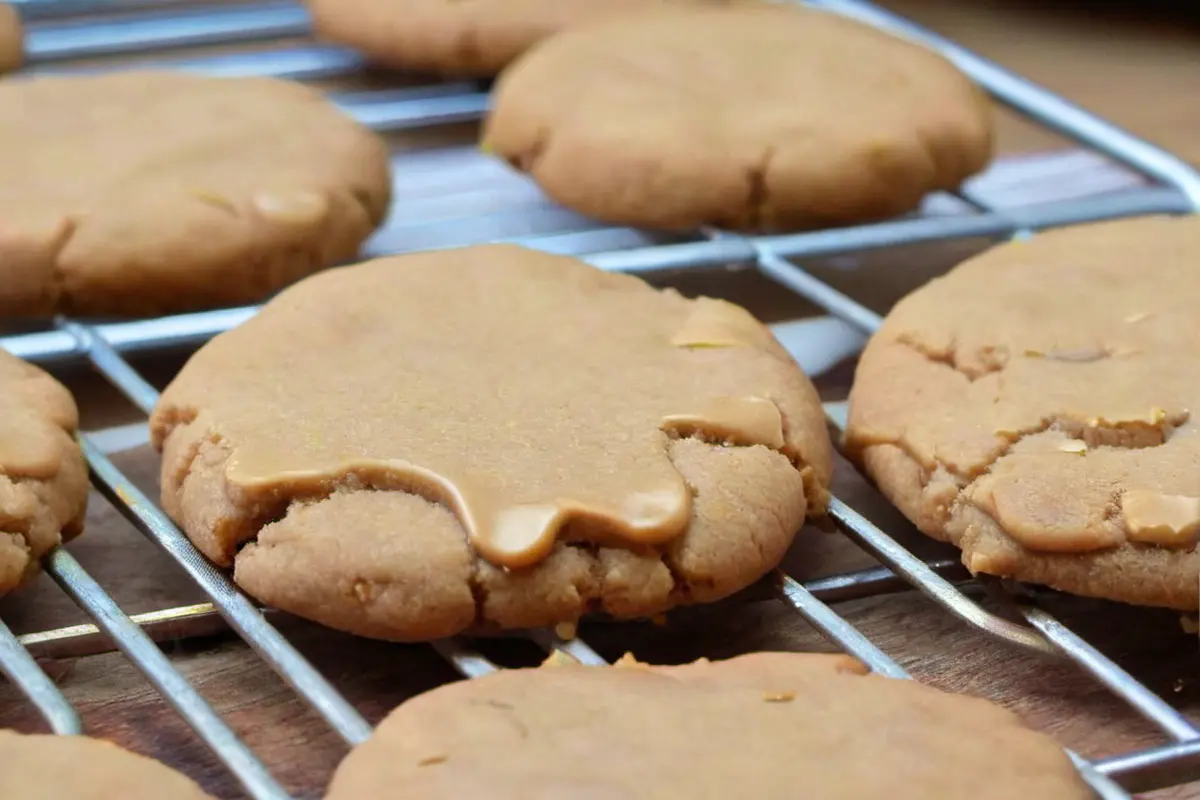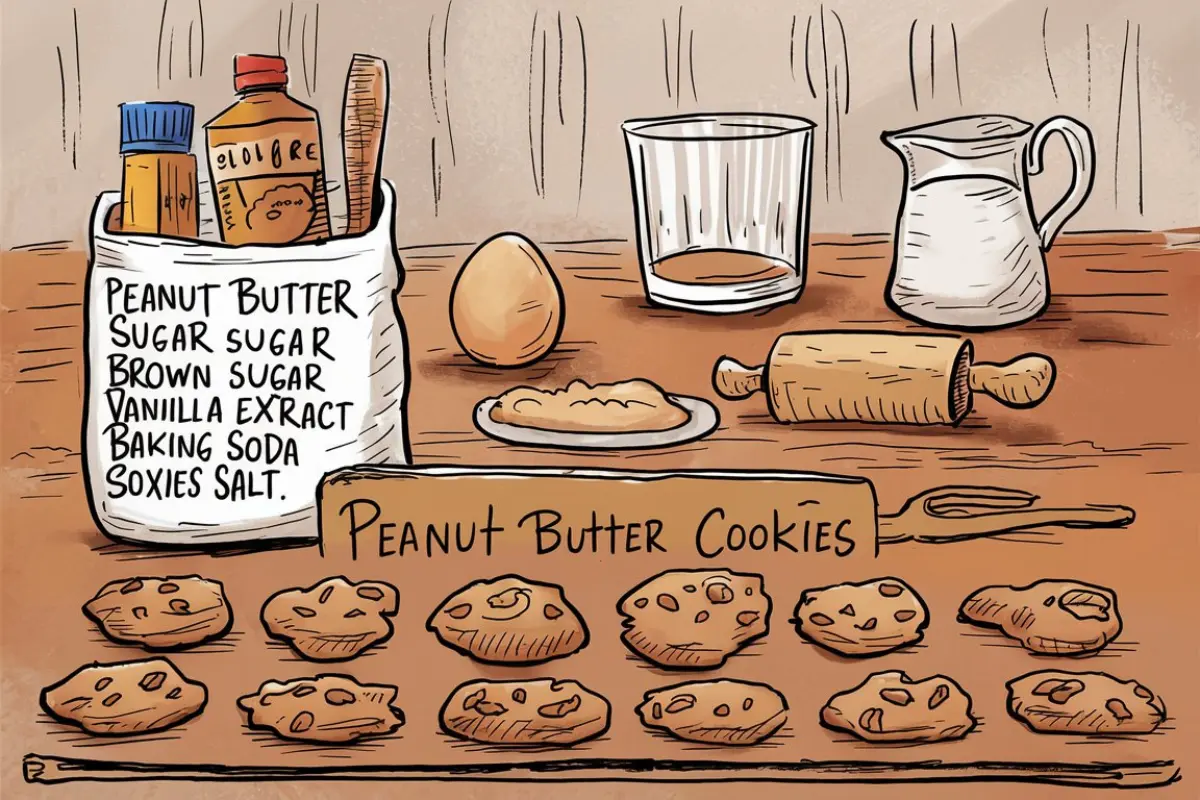Variations in Peanut Butter Cookie Recipes
Traditional vs. Modern Recipes
The classic peanut butter cookie recipe is a cherished formula, often involving nothing more than peanut butter, sugar, and an egg. This simplicity is what originally made it a household favorite. Yet, as culinary creativity blossomed, so did the variations of this beloved recipe. Modern takes on the traditional peanut butter cookie incorporate everything from chocolate chips and oats to exotic spices like cardamom or nutmeg, offering a delightful twist to the conventional flavor profile.
Gluten-Free and Vegan Options
Catering to dietary needs doesn’t mean sacrificing flavor. Gluten-free peanut butter cookies often substitute all-purpose flour with almond flour or oat flour, providing a rich, nutty undertone that complements the peanut butter. For vegans, replacing the egg with alternatives such as flaxseed meal or chia seeds mixed with water can yield surprisingly moist and flavorful cookies. These adaptations ensure everyone can enjoy a peanut butter cookie regardless of dietary restrictions. For an easy recipe without eggs, explore our vegan options that include delicious variations on traditional peanut butter cookies.
Add-ins and Flavor Enhancers
To elevate the basic peanut butter cookie, consider incorporating add-ins that enhance both texture and flavor. Options like chopped nuts provide a crunchy contrast to the soft cookie texture, while dried fruits such as cranberries or raisins offer a tart sweetness that cuts through the richness of the peanut butter. For a decadent twist, stir in chunks of dark chocolate or a swirl of caramel. The possibilities are endless, and each addition makes the simple peanut butter cookie even more special.
Exploring the various recipes and adaptations of peanut butter cookies reveals the versatility and enduring popularity of this simple dessert. By understanding the traditional foundations and embracing modern innovations, you can transform the humble peanut butter cookie into a customized treat that delights with every bite.
In the next section, we will delve into the baking techniques that ensure your peanut butter cookies come out perfect every time, from mixing methods to baking temperatures. Stay tuned as we continue our journey through the art of peanut butter cookie making!
How to Perfectly Bake Peanut Butter Cookies
Mixing Methods: How to Combine Ingredients
Achieving the perfect peanut butter cookie starts with the mixing process. It’s crucial to blend the peanut butter and sugar together until they’re light and fluffy—this introduces air into the mixture, which helps produce a lighter texture in the final cookies. When adding the egg or its substitute, make sure to incorporate it thoroughly to ensure an even distribution, which contributes to uniform baking and texture.

Baking Tips: Temperature and Timing
Baking temperature and time are pivotal in achieving the perfect peanut butter cookie. Most recipes call for baking at 350°F (175°C), which is ideal for creating a golden brown finish without burning the edges. The baking time might vary slightly depending on the size of your cookies, but generally, 8-10 minutes should suffice. Make sure to keep an eye on them and take them from the oven when the edges begin to change an almost golden shade Be aware that they may remain slightly cooked from leftover heat after removal of the oven.
Common Baking Mistakes and How to Avoid Them
One common mistake is overmixing the dough, which can lead to tough cookies. Once you add the flour (if used), mix just until it’s incorporated. Overworking the dough activates the gluten, which is great for bread but not for tender, crumbly cookies. Another tip is to ensure your baking soda or baking powder is fresh; this will help the cookies rise properly. Lastly, be consistent with the size of your cookie dough balls. Using a scoop or spoon can help ensure that all your cookies are uniform, which helps them bake evenly.
Mastering these techniques will not only improve the consistency and appearance of your peanut butter cookies but also enhance their flavor and texture. With a bit of practice and attention to detail, you can bake cookies that are sure to impress at any gathering or simply serve as a delightful treat for yourself.
Next, we will explore the nutritional information of peanut butter cookies, providing insights into how you can enjoy these treats in a healthier way. Stay tuned as we discuss how to balance indulgence with health in our favorite baked goods!
Nutritional Aspects of Peanut Butter Cookies
Caloric Content Analysis
Peanut butter cookies are undeniably tasty, but they can also be quite calorically dense, primarily due to the high fat content in peanut butter and the sugars used. For an in-depth look at the health benefits and nutritional aspects of peanut butter, including its protein and mineral content, check out this comprehensive resource. Typically, a standard peanut butter cookie might contain anywhere from 70 to 100 calories, depending on the size and specific ingredients used. For those monitoring their calorie intake, being aware of the portion sizes can help manage consumption without missing out on these delicious treats.
Healthier Substitutes for Traditional Ingredients
For those health-conscious bakers eager to enjoy peanut butter cookies without the guilt, a variety of substitutions are available to reduce calories and enhance nutritional value. Below is a table outlining ingredient variations that can be used in peanut butter cookies, which not only provide health benefits but also cater to different dietary needs and preferences. Whether you’re looking to decrease refined sugar intake or add nutritional supplements like omega-3 fatty acids, these substitutions will help you achieve a healthier version of your favorite treat.
| Ingredient Type |
Options |
Notes |
| Peanut Butter |
Commercial, Natural |
Commercial for stability, natural for a healthier option but may require adjustments |
| Sweeteners |
White Sugar, Brown Sugar, Honey, Maple Syrup |
White sugar for crispiness, brown for chewiness, honey/maple syrup for less refined sugar intake |
| Binders |
Eggs, Flaxseed Meal, Chia Seeds |
Eggs are traditional; flaxseed or chia seeds can be used as vegan alternatives |
Understanding these nutritional components allows you to enjoy peanut butter cookies in a way that fits your dietary needs without compromising on taste. By making small adjustments to the ingredients, you can create a cookie that’s not only satisfying but also better for your health.
Conclusion
Celebrating the Versatility of Peanut Butter Cookies
As we wrap up our exploration into the basic ingredients for peanut butter cookies, it’s clear that this beloved treat isn’t just a simple snack. It’s a versatile canvas for creativity in the kitchen. Whether you stick to the traditional recipe or venture into modern variations with unique add-ins and substitutes, peanut butter cookies offer something for everyone. They can be adapted to fit various dietary preferences and health considerations, proving that this classic cookie can evolve with our changing tastes and nutritional needs.
Embracing Creativity in Baking
The journey from a basic dough to delightful, golden-brown cookies is a testament to the joy of baking. Each batch offers a new opportunity to tweak and perfect your recipe, whether you’re aiming for the ultimate chewy texture or a crisper bite. Experimenting with different types of peanut butter, sugars, and flours not only enhances your culinary skills but also deepens your understanding of how ingredients work together.
A Treat for All Occasions
Peanut butter cookies are more than just a treat; they’re a warm, comforting presence that brings people together. They’re perfect for school lunches, holiday gatherings, or as a simple pleasure alongside your afternoon coffee. With the insights and tips provided in this guide, you’re well-equipped to bake these cookies to suit any occasion or preference.
We hope this article has inspired you to embrace the simple pleasures of baking and to explore the endless possibilities that peanut butter cookies offer. Remember, the best recipes are the ones that bring joy and a bit of sweetness into our lives. Happy baking, and may your cookies always be as delightful as your culinary adventures!
Next, we’ll look at some frequently asked questions about peanut butter cookies to help clear up common queries and provide more insights into making the perfect cookie. Stay tuned as we wrap up our comprehensive guide to peanut butter cookies with helpful tips and answers to popular concerns!
Frequently Asked Questions
Can I use natural peanut butter in cookies?
Yes, you can use natural peanut butter in your cookies. However, keep in mind that natural peanut butter tends to be less stable than its commercial counterparts due to its oil separation. This can affect the texture and consistency of your cookies. To combat this, you might need to adjust other ingredients, like increasing the flour slightly or adding a bit more binding agent to ensure the cookies don’t spread too much or become too oily.
How do I make my peanut butter cookies chewy or crunchy?
The texture of your peanut butter cookies can be adjusted by modifying a few key ingredients. For chewier cookies, opt for brown sugar instead of white sugar, as the molasses in brown sugar adds moisture. Additionally, underbaking the cookies slightly will keep them softer. For crunchier cookies, use white sugar and consider increasing the baking time by a few minutes to achieve a firmer texture. The amount of fat (peanut butter and additional butter, if used) can also influence the chewiness; less fat generally results in a crisper cookie.
How long do peanut butter cookies last?
Peanut butter cookies typically last about 5 to 7 days when stored properly in an airtight container at room temperature. If you want to extend their shelf life, you can freeze the cookies for up to 3 months. To enjoy them, simply thaw at room temperature or give them a quick warm-up in the oven or microwave to bring back their fresh-baked taste and texture.
These FAQs cover some of the most common inquiries about baking peanut butter cookies. Armed with these tips and tricks, you can tailor your baking experience to suit your preferences and ensure that every batch of cookies comes out just the way you like them. Now that you’re equipped with knowledge from ingredients to baking techniques and adjustments for dietary needs, you’re all set to bake the perfect peanut butter cookies that everyone can enjoy.
Stay tuned for more culinary adventures and happy baking!



